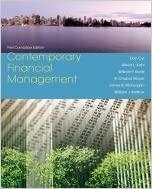Answered step by step
Verified Expert Solution
Question
1 Approved Answer
At the end of five years, Meg estimates that the growth rate in cash flows will be 3 . 5 percent per year. The capital
At the end of five years, Meg estimates that the growth rate in cash flows will be percent per
year. The capital expenditures are for new projects and the replacement of equipment that wears
out. Additionally, the company would realize cash flow from the sale of several divisions. Even
though the company will sell these divisions, overall sales should increase because of a more
concentrated effort on the remaining divisions.
After plowing through the companys financials and various pro forma scenarios, Ben and
Brenton feel that in five years they will be able to sell the company to another party or take it
public again. They are also aware that they will have to borrow a considerable amount of the
purchase price. The interest payments on the debt for each of the next five years if the LBO is
undertaken will be these in millions:
Interest payments $ $ $ $ $
The company currently has a required return on assets of percent. Because of the high debt
level, the debt will carry a yield to maturity of percent for the next five years. When the debt
is refinanced in five years, they believe the new yield to maturity will be percent.
CPI currently has million shares of stock outstanding that sell for $ per share. The
corporate tax rate is percent.
QUESTION:
If Meg, Ben, and Brenton decide to undertake the LBO, what is the most they should offer per
share?
Note: Just like in the RJR example from Appendix A computing the value of the firm comes
down to getting the present value of its future cash flows, which can be broken conceptually into
four steps:
Step : Calculating the present value of unlevered cash flows for the first five years.
Step : Calculating the present value of the unlevered cash flows beyond the first five years.
Step : Calculating the present value of interest tax shields for the first five years.
Step : Calculating the present value of interest tax shields beyond the first five years.
Step by Step Solution
There are 3 Steps involved in it
Step: 1

Get Instant Access to Expert-Tailored Solutions
See step-by-step solutions with expert insights and AI powered tools for academic success
Step: 2

Step: 3

Ace Your Homework with AI
Get the answers you need in no time with our AI-driven, step-by-step assistance
Get Started


